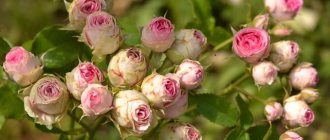The English rose "Graham Thomas" is a very popular variety, which has become famous for its delightful bright yellow flowers with a romantic shape. A luxurious bush, densely strewn with fragrant sunny buds, immediately attracts attention and is simply impossible not to notice.
The Graham Thomas bush (pictured) blooms profusely in early summer, then blooms more moderately, in waves, until the end of the season
This variety is considered one of the best representatives of nostalgic roses bred by the famous breeder David Austin. The variety has received recognition from specialists and amateur gardeners, as it has an excellent appearance, long and abundant flowering, good disease resistance and high frost resistance. Roses are grown as a tapeworm and in groups; they look great in combination with other plants in the garden landscape, creating a romantic mood and filling it with bright colors.
The table contains brief information about the variety:
| Parameter | Characteristic |
| Culture | Rose (Rosa L.) |
| Variety | "Graham Thomas" (AUSmas, Lemon Parody, English Yellow) |
| Garden group | Modern Shrub, English Roses |
| Form | Bush |
| Life cycle | perennial |
| Purpose | Decorative |
| Reproduction | Vegetative (by cuttings) |
| Bush height | 100-150 cm (up to 305 cm) |
| Flowering type | Continuously blooming |
| Flowering period | From June to September, in the southern regions - until frost |
| Type of flower | Terry |
| Number of petals | 26-40 pcs. |
| Flower diameter | 10-12 cm |
| Petal coloring | Bright yellow |
| Disease resistance | High |
| Frost resistance | Up to −23.3 ℃ |
| Registration in the State Register of the Russian Federation | Absent |
Description of the variety Graham Thomas
The yellow rose variety Graham Thomas tolerates diseases well if properly cared for, because in unfavorable years the plant is susceptible to infection, so timely treatment at this time is especially important. The culture is winter-hardy; some flowers do not open in rainy weather. The variety blooms profusely all summer intermittently.
| Color | Yellow |
| Number of flowers per stem | From 3 to 5 |
| Aroma | Strong |
| Flower size | 10-12 cm |
| Bush height | 100-120 cm |
| Bush width | 100 cm |
| Frost resistance | Frost-resistant, zone 6 |
| Powdery mildew resistance | Average, gets sick in unfavorable years |
| Black spot resistance | Average, gets sick in unfavorable years |
| Rain resistance | Average, some flowers do not open when it rains |
| Bloom | Reblooming |
| Bush shape | Spreading |
| Flower | Dense double |
Shelter for the winter
A distinctive feature of this type of culture is its resistance to cold. Before wintering, Graham Thomas roses need to be pruned short, to the very base, on which two or three buds are left. The pruning shears used for this manipulation must be pre-treated with a disinfectant solution. Afterwards, the bush is sprinkled with earth, which is lightly compacted to ensure the preservation of heat in the root zone of the plant.
The crop is covered with leaves, spruce branches or sawdust. In conditions of extremely low temperatures (20 degrees and above), better protection for the rose can be provided by covering it with a layer of thick film on top. In this case, you should remember the mandatory gap between the rose and the film, which should be at least fifteen centimeters. The result will be an improvised but reliable greenhouse, inside which the plant will feel comfortable and protected. To prevent the film from being blown away by the wind, it can be additionally sprinkled with dry branches. This type of shelter will provide the shrub with a sufficient amount of sunlight and will protect it well from spring weather.
Rose Graham Thomas is a wonderful variety that will be a worthy decoration for any summer cottage or country house. With proper care, it will always delight its owner with beautiful flowering and exquisite English sophistication, which will not leave any guest indifferent.
Bush rose Graham Thomas, brief overview, description of characteristics:
Appearance and features
Graham Thomas rose has a light yellow tint, not flashy, but rich. The flowers look like drops of liquid honey, some buds have a brighter peach color. The petals on the flowers are tightly packed together to create a perfect cupped shape with a closed core. The edges of the petals are wavy, the buds are densely double and fluffy.
The bush blooms with 3-5 buds of the same color and shape. The plant grows quickly, spreading its shoots with lush green foliage a meter wide. In cool climates, the bush grows up to one and a half meters in height; in the south, the plant can reach two to three meters. The culture is spreading, with many bright roses. The buds are characterized by a pronounced aroma of tea rose.
Abraham Darby
The variety was bred in 1985, an English rose, distinguished by a very strong, rich fruity aroma. The flowers are one of the largest of the entire species, have the classic, cupped shape that old roses have, in the center they are copper-apricot in color, towards the edges the petals acquire a pinker hue. Bicolor is especially noticeable in cold weather, in hot weather, at high temperatures, the flowers become simply monochromatic, pure apricot color. Flowers are formed at the ends of long shoots, either one at a time or quite often in small clusters, up to 3 pieces. This is a strong variety of roses, resistant to diseases; in landscape design it is often used as a climbing rose - it will require support, since under its own weight the flowers droop, bending the shoot, this is especially evident in young roses. Over time, as the shoot strengthens, the problem disappears. It has a good bush shape and quickly re-blooms.
The Abraham Darby variety was developed in 1985. It is curious that both varieties in the parent pair are modern - this is not typical for Austin's breeding work. "Abraham Darby" has magnificent flowers of an ancient shape, 12-14 cm in diameter, densely double (up to 140 petals). Coloring - delicate, pastel shades
Photo
anastasy_a_
milas_hobby
ekaterina__illusion_
an_kozyreva
volham
History of origin
The Graham Thomas variety was bred in the UK by the Austin breeding company in 1983. Because of its color, the rose was named Lemon Parody. The variety is considered a hybrid tea, but some experts attribute it to the Shrubs group.
Roses of this shape were popular at the beginning of the 20th century, later roses of the classical form received universal love, but in the 80s of the last century, densely double cupped buds again became in demand.
At the behest of fashion, the Graham Thomas rose appeared. The culture was obtained through crossing the Iceberg and Charles Austin varieties. Rose Graham Thomas is a symbol of love in her homeland, because here they always give yellow roses to lovers when confessing their feelings.
Growing and caring for roses Graham Thomas
To plant Graham Thomas roses, choose sunny areas or places in partial shade. Without sunlight, the buds of the crop will be pale. The plant must be in the sun for at least 6 hours a day. The rose garden with the variety should be located in a place that is well ventilated.
The choice of planting location depends on what kind of shrub the gardener wants to have. If his dreams are for a compact bush with a lot of bright flowers, the area should be in open sun. If you need a spreading, wide bush with dark foliage and small inflorescences, the best choice is partial shade. It is better to plant a seedling in mid-spring or towards the end of autumn.
Step-by-step instruction
Place
Rose Graham Thomas loves diffused bright light . It also grows well in semi-shaded areas, but the flowering will not be as abundant, the flowers will have a pale yellow color. For full growth, the variety needs up to 5–6 hours of daylight per day.
The bushes should be well ventilated; stagnant air in dense plantings provokes the appearance of harmful pests and diseases.
The soil
The soil should be:
- fertile;
- acidified;
- light;
- drained.
For growing in tubs, it is recommended to use the following soil mixture:
- Garden soil – 2 hours.
- Sand – 1 hour.
- Turf soil – 1 hour.
- Leaf soil - 1 tsp.
- Humus – 1 hour.
- Dried clay – 1 tsp.
- Drainage.
Drainage layer, up to 4 - 6 cm, the drainage composition includes coarse sand, clay fragments, pebbles.
Regular loosening (shallow) of the soil and removal of weeds is required.
Landing
In southern climates, you can sow seeds in the fall, in a shallow trench, so that the seeds undergo natural stratification.- The top of the trench is sprinkled with a layer of a mixture of sand and soil.
- The sowing is sprinkled with leaves and covered with coniferous spruce branches.
- Covering material is fixed on top. Holes are left at the base to prevent the crops from rotting and rotting.
- In the spring, the shelter is removed, the soil is cleared of leaves, and seedlings begin to emerge (which varieties do not need shelter for the winter?).
Seedlings grown in this way are more resistant to disease, quickly adapt and take root in a new place.
You can germinate seeds in a greenhouse.
The seeds are pre-soaked in any growth hormone for 2 hours . The procedure is carried out in early autumn.
Rules for growing crops in a greenhouse:
- The seeds are laid out on a moist soil mixture without being buried.
- The sowing is sprinkled with a layer of sand, up to 0.5 cm.
- The soil is moistened and the seeds are lightly pressed.
- The sowing is covered with film.
- Air temperature for germination is 20 – 22 °C.
- The light is bright, watering is moderate, through a spray bottle.
- Ventilate the greenhouse daily for 10-15 minutes. in a day.
- After 3 weeks, the greenhouse is transferred to the basement or installed in a cool room, the air temperature is 7 - 8 °C.
- After 2 - 3 months, the seedlings are taken to a bright place.
Seedlings should be accustomed to light and fresh air gradually.
Temperature
The optimal temperature for keeping a rose in a tub or flowerpot is up to 22 – 25 °C.
In the flowerbed, when the temperature rises to 28 - 30°C, the rose will need additional moisture - spraying the bushes in the morning.
The variety tolerates a drop in air temperature in autumn , down to 12 - 15 °C. The bush continues to bloom until September - early October.
Watering
Watering is regular, up to 5 liters of water are spent on young bushes, for adult bushes the volume of water increases. Water for irrigation should be used only clean, settled, and at room temperature.
In autumn, watering is reduced . The amount of precipitation that falls is sufficient to moisten the air and soil.
After rain and spraying, the branches must be shaken off so that water does not linger in the dense inflorescences.
Top dressing
Before planting, add a bucket of compost mixed with 300 g of ash to the soil.
In early spring, nitrogen fertilizers are used for shoot growth for rapid growth and restoration of stems after winter.
In summer, the soil is fertilized with mineral complexes of potassium-phosphorus fertilizers.
Flower growers recommend using special fertilizers:
- "Hera";
- "Agricola";
- “Clean slate”, etc.
Mineral fertilizers should be alternated with organic fertilizers:
- chicken droppings;
- cow dung;
- weed tincture.
Trimming
- Spring pruning (to form a beautiful bush and clean it after winter):
- Long shoots less than 1 cm in diameter are removed.
- Sick, dry, damaged stems are cut out.
- Thick stems are cut to a third of their entire length.
- The cut areas are sprinkled with activated charcoal or charcoal.
- Autumn pruning (to prepare the bush for winter rest):
- Late autumn is the optimal time for pruning. Shoots that are too long are cut off.
- Each remaining stem should have 6–7 buds.
- Shoots damaged by pests and viruses are cut out at the root.
- Stems that have not ripened during the season are removed.
- Up to 5 healthy shoots are left on each bush for the winter.
Pruning is carried out in sunny, dry weather. Thick stems are cut off with a hacksaw. All leaves from the stems are completely removed.
Transfer
The procedure is carried out in early spring if the bush has grown greatly.
Transplant rules:
- The mother bush is dug up and cleared of soil.
- A seedling or separated bush is soaked with its roots in warm water for 7–8 hours.
- The planting hole should correspond to the size of the root, up to 30 - 40 cm in diameter and up to 45 cm in depth.
- A mixture of clay, manure and water is placed at the bottom of the hole (for quick rooting).
- The bush is lowered vertically, the root shoots are lowered into the prepared soil mixture.
- The bush is sprinkled, forming a small mound (for soil subsidence).
- Abundant and regular watering.
- Feeding after 2 - 3 weeks.
Preparing for winter
- Since the end of August, the volume of water for irrigation has been reduced.
The soil should not be moistened before wintering. - Fertilize the soil with superphosphate and potassium.
- The soil should be loosened only until September.
- In October, the bush is dug in with soil, covered with dry spruce branches, leaves, etc.
- In areas with harsh winters, film, agrofibre, burlap, etc. are fixed on top of the shelter.
Diseases
Are there dark spots on the shoots of the rose? This could be necrosis, find out how to save the plant
Bark necrosis on roses
Does the rose begin to wither and die for no apparent reason? It could be root rot, find out control and prevention measures
Root rot of roses
Girdle spots of brick and burgundy shades appear on the shoots of roses, find out why this happens
Infectious rose burn
Are there growths and cracks on the rose? It could be cancer, read what to do next
Common rose cancer
The seedling must be kept in a solution that stimulates growth for 24 hours. The bush is planted in a hole 50 cm deep, the width of the hole and the distance between the bushes should be the same.
Before planting the plant, the holes need to be watered abundantly, using 10 liters of water for each hole. The roots are carefully distributed over the hole, and the bush is covered with substrate. The grafting bud should be at a depth of 7 cm. The soil should be compacted, and after a day the bush should be loosened and watered.
Rose Graham Thomas loves humidity. Watering should not be excessive so that the roots of the plant do not rot, but the soil should not be allowed to dry out completely. If the top layer of soil has dried out, you must immediately water the plant.
To ensure successful flowering, it is recommended to fertilize the seedlings with fertilizers containing phosphorus and calcium. The optimal period for fertilization is May and June, at which time the buds ripen.
In the autumn, you need to fertilize with potassium. Pruning of spreading shrubs is carried out based on the preferences of the owner of the rose, regarding ideas about landscape design on his site. Sick and frost-damaged shoots must be removed.
Graham Thomas is susceptible to infection with various types of diseases, so you need to carefully monitor the condition of the bush. There must be a drainage layer at the bottom of the hole so that there is no stagnation of moisture in the root system.
After rain, you need to remove drops of moisture from the leaves and buds to avoid sunburn. Most often, the crop of this variety suffers from gray rot, which is formed from stagnant moisture and prolonged rains.
This fungal infection affects the roots. A symptom of the disease is rotting leaves and shoots. If an infection has affected the bush, it is necessary to remove the diseased areas of the plant and carry out disinfection; the substances Alirin-B and Fitosporin-M are suitable.
English roses by David Austin | About the rose
Caring for indoor roses in autumn and winter
Ant Ale
The value of David Austin's English roses is obvious to gardeners. The English breeder, having crossed ancient rose varieties with modern hybrid tea varieties, achieved a magnificent appearance, a rich aromatic spectrum, and a long flowering period of the plant.
Graham Thomas
Ancient rose (French, Bourbon, Damask) imparted aristocratic beauty and a wonderful aroma to the flowers. Modern plants have added practical qualities: varied colors, resistance to external factors, secondary flowering.
Distinctive features of Austin English roses
Rose Abraham Darby
The first ostina was obtained by crossing the modern floribunda rose and the ancient Gallic rose. Today, there are officially more than two hundred species of David Austin roses.
buds
Austins are characterized by both delicate, soft shades and rich, deep colors. Dense, densely double English roses are cup-shaped, pompom-shaped and rosette-shaped. The folded petals in a flower surprise with their multitude and create a velvety effect.
Bushes
The current garden classification classifies most varieties of Austin's Englishworts as scrub roses - shrub roses. The bushes of the plant, unlike the upright hybrid teas and floribundas, have a rounded shape and are well formed. The flowers are located throughout the lush bush, thereby increasing the decorative effect.
Rose A Shropshire Lad
Aroma
English roses are distinguished by their exquisite combination of aromas - from fruity, myrrh, musky shades to the scent of old and tea roses. In the morning and evening their fragrance is especially pronounced.
Flowering duration
The David Austin rose blooms in early June, earlier than other species. Flowers luxuriantly cover the entire bush, starting from its lower part. The end of August, the beginning of September is the time of secondary flowering of the saplings.
Endurance
Rose Benjamin Britten
Many plant varieties have good shade tolerance. They are planted in both partial shade and sun. Winter hardiness is a distinctive quality of the English rose. It tolerates frosts and thaws, heavy snow and its absence well. This Englishwoman is especially good in our climate.
Flaws:
- The disadvantages of peony roses include the rose's sensitivity to rain and humidity. In rainy weather, wet flowers may rot and not bloom. Excessive soil moisture provokes fungal diseases of the plant.
- In extreme heat, English rose flowers become small and quickly fade.
- Flexible branches of bushes often need additional support, but it is easier to winterize the rose.
The advantage of English roses grafted onto a rootstock with white roots is the absence of wild growth.
How to plant an English rose, care features
Rose Ret Austin (Pat Austin)
Before planting plants, compost or rotted manure, preferably horse manure, is added to the soil. Rose roots are pre-treated with growth stimulants. The width and depth of the hole for the rose should be large enough. The remains are usually buried ten centimeters. To form a lush thicket, roses are placed half a meter from each other in a triangle.
June is the time to add nitrogen fertilizers to the soil to better form green mass. During budding, plants need phosphorus and calcium.
When caring for a rose, you should not allow the soil to dry out. In rainy weather there is a risk of the plant becoming infected with gray mold. The color of the bud is light brown; its falling off when touched indicates illness.
The bush needs urgent pruning of the affected part.
For the appearance of new flowers and repeated flowering, the rose is pruned. This procedure is carried out in April before the buds open.
When pruning, low-quality shoots are removed, healing and rejuvenating the plant, and setting the shape of the bush. To grow climbing roses, pruning of lateral and weak shoots is done.
If the rose will serve as a border decoration, all bushes of the plant are cut at the same distance - about sixty centimeters.
Rose James Galway James Galway
In our country, English roses of the varieties Graham Thomas (a favorite of rich yellow color, tea rose aroma), Abraham Darby (apricot shades of the bud, strong fruity aroma), Shropshire Lad (gentle peach color, has a fruity aroma) are popular.
Contrasting orange shades give the rich red buds of Benjamin Britten an unusually elegant look.
English roses by David Austin are a wonderful element of landscape design, an outright joy for connoisseurs of graceful beauty.
Moloshonkova Natalya
Pests
Microscopic spiders have appeared on the plant, and the rose is gradually becoming covered with cobwebs, what should I do?
Spider mite
Are small green insects destroying your rose? Effective methods of pest control.
Green rose aphid
Caterpillars have appeared on the rose and are twisting the leaves of the plant, how to deal with the pest
Rose leaf roller
Flat bumps have appeared on the shoots of the rose or on the underside of the foliage, how to deal with the pest
Rosen scale insect
Several shrubs planted nearby can form a hedge. In the southern regions, where the climate is warm, the rose will begin to grow rapidly upward, so it can be placed along an arch or pergola.
In a flower garden, it is advisable to place a tall bush at the back; annual contrasting flowering plants, for example, petunia, verbena, forget-me-not, etc., will look good next to it. The variety is combined with plants of blue, violet, lilac and blue shades.
Cultivation Recommendations
The shrub is hardy to weather conditions, resistant to diseases and pests. When growing it, it is enough to adhere to the basic rules of agricultural technology, which include regular watering, pruning, fertilizing and, if necessary, shelter for the winter.
It is recommended to purchase seedlings from nearby nurseries - such plants, as a rule, correspond to varietal characteristics and are better adapted to the local climate
For planting, it is better to choose places that are well lit by the sun; in the shade, the shoots become very elongated and become weak. The plant is suitable for all types of soil, but one should not forget about fertilizing with organic and mineral fertilizers.
The bush is characterized by active growth, so it needs regular pruning. In the northern regions, the height of the plant usually does not exceed 150 cm, and the rose looks like a tall shrub. In the southern regions, the length of the shoots reaches 300 cm; they can be sent along vertical or horizontal supports, and then the plant will have a climbing shape. In a temperate climate, the variety can be grown in two ways - allowing the shoots to grow as much as possible and fixing them on a support, or cutting them in half after the end of the first wave of flowering, which promotes branching and the formation of a lush scrub.
The variety is suitable for cultivation in standard culture
Although “Graham Thomas” is frost-resistant, in the harsh Russian climate it needs winter shelter.
In landscape design, the variety is used for single and group plantings. The rose harmonizes perfectly with plants blooming blue, blue and lilac flowers - irises, clematis, bells, lavender and others.
The bushes look impressive in mixborders and natural flower beds in combination with white and blue-violet flowers
Useful tips
- When planting spreading shrubs, it is necessary to follow the rules for plant placement. There should be no fruit trees near the rose bushes at a distance of one meter. Otherwise, the crops will take nutrients from the soil from each other, which will negatively affect the growth of both plants;
- The variety is winter-hardy, but it needs to be covered for the winter in severe frost. The bush needs to be trimmed, leaving the base and a few shoots, then sprinkled with soil and covered with sawdust or dry leaves;
- It is recommended to fertilize the Graham Thomas variety according to the principle “It is better to underfeed a little than to overfeed.”
Seedling storage
After purchase, the bare roots should be wrapped in a damp cloth, and a film should be secured over it to retain moisture when transporting the seedling. If the roots are still a little dry, they are soaked for a day in a container of water. If it is not possible to plant the plant right away, the root is again wrapped in a wet cloth in several layers, and then covered with polyethylene and left in a cool place. Shoots with closed roots, packed in film, should be kept in a cool room (up to 10˚C) until planting without unpacking.
An example of storing rose seedlings
There are other storage methods:
- They dig a narrow trench up to 20 cm deep, carefully place the seedlings along one side, and cover the roots and lower parts of the shoots with soil. After this, the soil is thoroughly compacted and shelter from rain is provided;
- When purchasing seedlings in late autumn, the roots are cut to 30 cm, the shoots are shortened, and dry or damaged parts are cut out. After this, the plants are placed in boxes and covered with wet sand. An unheated basement that does not freeze even in severe frosts is best suited for storage.
Rose seedlings - photo
Pros and cons of the variety
Advantages:
- Good immunity, which is ensured by proper care and protects the plant from diseases;
- Bright color and lush buds;
- Sprawling bush with rich greenery;
- Pleasant, intense aroma;
- Frost resistance;
- Different ways to create original landscape design using this culture.
Flaws:
- If not properly cared for, it becomes infected with fungus and other diseases;
- Cannot be grown for cutting due to the location of the inflorescences on the stem;
Flower propagation
English roses are propagated mainly by cuttings. Sometimes a method using layering is used.
When is it produced?
The propagation procedure is best carried out in spring or early summer before flowering. At this time, the flower has good survival rate.
Important! To propagate a rose using cuttings, you need to select strong and healthy branches and trim them so that each branch has at least three leaves. Before planting in the ground, it is important to soak the cuttings in a special solution so that they take root. Then they are planted in open ground, each in a separate hole.











